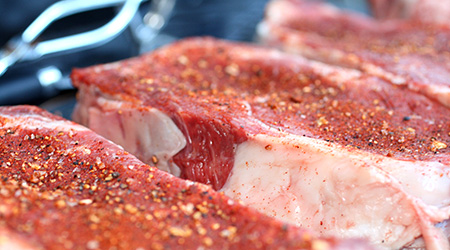How To Cut Your Meat Bill

Going grocery shopping can be a stressful experience especially if your family is full of carnivores. Meat can be a significant portion of a grocery budget and looking for ways to minimize this expense can be time consuming and frustrating for the uninitiated. Regardless of the overriding expense of meat related items, health implications should also be considered when planning family meals.
The easiest way to have an immediate impact of the meat portion of the family food budget is to plan dinner menus. Randomly purchasing grocery items including meat because something sounds interesting or you always buy pot roast or hamburger is a great way to buy food you don't need or won't be using any time soon. Meat, or more generally, protein is a necessary part of all well balanced meals but purchasing a box of twenty frozen hamburger patties does not a meal make. Not only do dinner menus reduce expenses overall but they also mean less meat is purchased because it is planned for specific meals.
But how do you plan a dinner menu? Simple, use the Government and other association approved food pyramids. Protein, including meat products, is a proportionally small part of a well balanced meal. Vegetables should be a primary part of the overall meal and as such purchasing meat becomes less expensive. Many online resources have sample dinner menus which incorporate the food pyramid which can help in planning family meals. You may also find that when trying to incorporate food pyramid items that you may be using meat less often and using more fish and chicken. Meat doesn't have to be apart of every meal but when it is it should be in much smaller portions than what most families consume.
This leads to portion control. Meat can be an expensive part of most meals and having smaller portions is not only less expensive but also healthier. The recommended size of most meat related portions is normally four to six ounces. It might sound small and unsatisfying but quality well prepared meat using herbs and spices can be more appetizing than three hamburgers. In fact since most meat is also high in saturated fats smaller portions, while costing less, is also more heart healthy.
Budget tends to set off red flags for most families because it normally involves sacrificing those items we enjoy most like sugary and fatty foods. In reality, a budget is just a guideline. It is a goal to hit when purchasing anything so that costs are kept under control. With dinner menus already planned, keeping to a budget should be fairly simple because the only meat which will be purchased will be that which is already accounted for. If you are going to have pork chops with scalloped potatoes and fresh green beans then you only need to purchase a four pack of pork chops and not a heavily marketed super pack of sixteen.
There are many ways to cut a meat bill when purchasing groceries for the family and when taken in combination can lead to significant savings. Saving money when looking to buy meat can be as simple as buy only what you need (plan), buy smaller amounts (portion) and set a cap for the most you are willing to spend (budget). By incorporating these three steps you can have dramatic cost reductions and still enjoy many different type of meat when making dinner.







